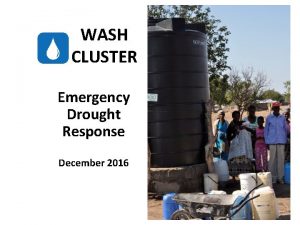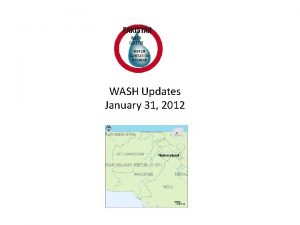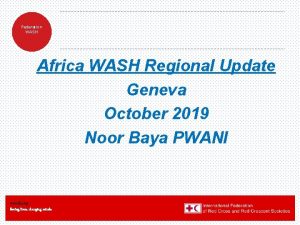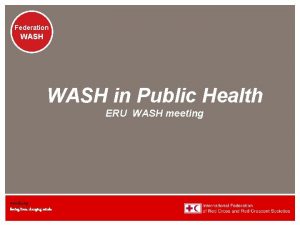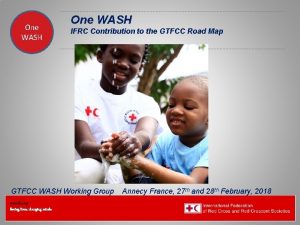SESSION 4 1 STANDARDS FOR WASH IN EMERGENCY

















- Slides: 17

SESSION 4. 1 STANDARDS FOR WASH IN EMERGENCY

Session Outline SPHERE & other standards Standards vs. Indicators WASH standards and indicators

FIRST: there are different standards… Really?

Cluster UNHCR UNICEF https: //emergency. unhcr. org/ http: //wash. unhcr. org/wash-indicators/ https: //play. google. com/store/apps/details? id=org. unhc r. emergency NATIONAL STANDARDS

Your Turn! Do you remember the standard for water supply in SPHERE? Your name on the back Exercise

Your Turn! Exercise 4 GROUPS You represent UNICEF and you are expected to follow the CCC The cluster coordinator is asking to follow SPHERE. ARE YOU IN TROUBLE? WHY?

Minimum standards: Objective Commitment Key indicators: Benchmark Key actions: Impact Indicator Output Indicator Programme Actions Guidance notes: Technical Justification Programme Actions

Standards A volunteer to read the standards for water in SPHERE, in CCC and in UNHCR All people have safe and equitable access to a sufficient quantity of water for drinking, cooking and personal and domestic hygiene. Public water points are sufficiently close to households to enable use of th minimum water requirements Children and women access sufficient water of appropriate quality and quantity for drinking, cooking and maintaining personal hygiene. Refugees and other Persons of Concern have safe access to water in sufficient quality and quantity. (From UNHCR Global Strategy for Public Health)

Standards All people access sufficient water Children and women access sufficient water Provide sufficient water for the persons of concern

Your Turn! Exercise Let’s check your answers

FIRST: there are different standards…

c i f ci ‘signals’ Indicators x te n o C e p s t Qualitative or quantitative show standard achieved

Indicators USEFUL PLANNING FIGURES Survival: 2. 5 -3 l person / day (depends…) Hygiene 2 -6 Cooking 3 -6 Total: 7. 515 at least 7. 5– 15 litres each per day. For domestic needs and personal hygiene, 20 litres person per day. Survival is 7 litres per day

HUMANITARIAN PRINCIPLES Humanitarian Imperative: Human suffering must be addressed with particular attention to the most vulnerable such as children, women, displaced population & elderly. Neutrality: Humanitarian Agencies must not take sides in hostilities (also know circumstances when military assets can be used). Impartiality (non-discrimination): Aid is delivered to all those who are suffering (those most in need) Do no/less harm: Strive to do no harm or limit harm.

Accountability: Humanitarian Agencies should hold themselves accountable to beneficiaries and donors. . and Government Participation: Participation of beneficiaries in decision making and their capacity development should be ensured Respect for culture and custom: Some interventions require particular sensitivity to local customs (customs can vary but human rights are universal) and ………………. UNIVERSALITY

The Key messages: Standards vs Indicators are context specific All rooted into humanitarian principles

THANK YOU
 The standards of prehospital emergency care
The standards of prehospital emergency care Customer defined service standards
Customer defined service standards Tobinskatten för och nackdelar
Tobinskatten för och nackdelar Tack för att ni lyssnade bild
Tack för att ni lyssnade bild Tack för att ni har lyssnat
Tack för att ni har lyssnat Referatmarkeringar
Referatmarkeringar Karttecken brant
Karttecken brant Epiteltyper
Epiteltyper Lufttryck formel
Lufttryck formel Vilka tal pekar pilarna på
Vilka tal pekar pilarna på Adressändring ideell förening
Adressändring ideell förening Elektronik för barn
Elektronik för barn Borra hål för knoppar
Borra hål för knoppar Bra mat för unga idrottare
Bra mat för unga idrottare Smärtskolan kunskap för livet
Smärtskolan kunskap för livet Bris för vuxna
Bris för vuxna Argument för teckenspråk som minoritetsspråk
Argument för teckenspråk som minoritetsspråk Frgar
Frgar




















